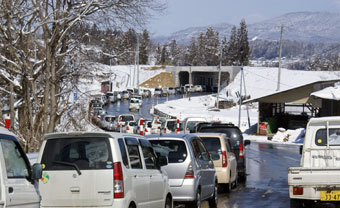Aeneas Wilder: Writings Iwate EarthQuake 2011Times are Japanese standard time.
Friday 18th March
| 18th March | It was -8 degrees last night, inland in Iwate. The coast will have been warmer. below are the photos and text detailing our trip to Kamaishi and Ofunato. We departed 11:30 and returned by 23:00 |
Text of our journey |
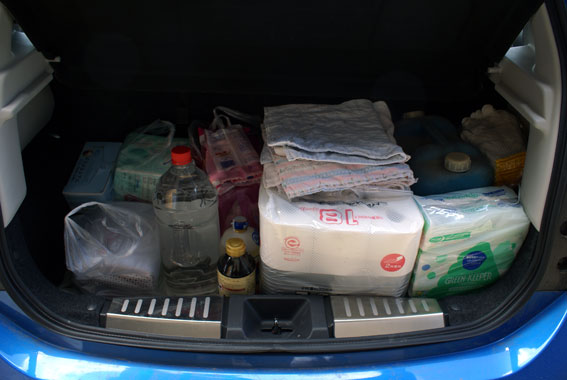 |
The diesel vehicle for delivery has been running to and from Kamaishi for several days. We hoped that a second vehicle would be available to take or be driven by us today. However, this is no longer possible. Naoko and I decided to take what we could, using our small Nissan March. We stocked the car with toilet rolls, excess underwear, nappies, sanitary towels, candles and a jerry can of Kerosene, water, miso paste, rice, dried noodles and other basic food stuffs. We had been told that all roads in, around, to and from the cost were now open. | |
A 90 minute drive brings us to the outskirts of Kamaish |
|
During the drive we listened to the radio news. We heard that Ofunato was going to have delivered 2000 litres of petrol available for civilian consumption, rationed at 3000 yen per vehicle – probably means 20 litres each for the first 100 vehicles. The road to Kamaishi was quiet until we were about 10kms from the town.. We start seeing a lot of military vehicles and have 5 or so civilian cars behind ours as we pass through the three mountain tunnels (2, 3 and 4.5kms long) that are a recent upgrade on the road to the coast. The tunnels were all without electricity. |
People queue to use a land line |
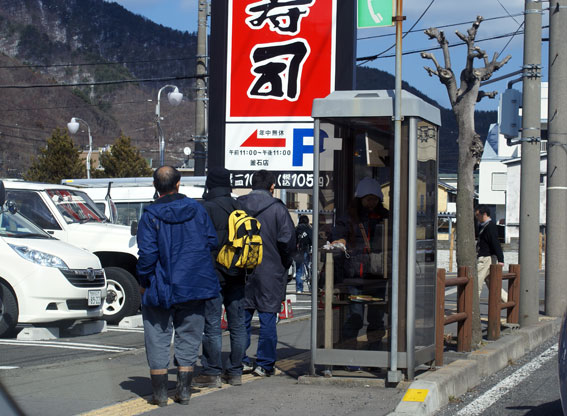 |
As we descend into Kamaishi you begin to see a lot of traffic, mostly heading out, in or around town. Everything else looks normal until we reach the train station. The remaining photos are all taken from this point onwards down towards Ofunato.We knew where we had to get to ,the temporary municipal headquarters, located, we believed close to the harbour. Although almost every main street had a wide bulldozed channel, we quickly became disorientated due to the exstensive devistation.
|
 |
We parked the car close by our friends (the Sawada family) house. We decided to take a quick look and see if it was still there. Again we became disorientated/lost as there were no familiar points of reference beyond memory and the major buildings still intact. After some mis-confirmations and having asked several locals, we finally found the spot where the house still stands. We were not allowed access to this small area of street as it is the last bit of main street still full of debris. | |
Railbridge just south of the train station |
 |
We walked up some way between Hamacho 1 and Hamacho 2 to the nearest refuge shelter, closest to their house to make inquiries about the father of our friend. Sadly we were told he had died. We then made our way through the streets to the hospital/ health centre which was acting as an information point and then to the temporary municipal HQ housed in Kamaishi Junior high school, where Yukako Sawada was working. She is a city council worker – and this being a Friday she was working. Naoko spoke with her for some time. Many people have lost family. However, the main role of administration and disaster relief/support is being conducted by the local populations of each devastated region. Search and rescue has finished in Kamaishi. They will begin dismantling the down town area. |
Typical traffic on route 45 within Kamaishi |
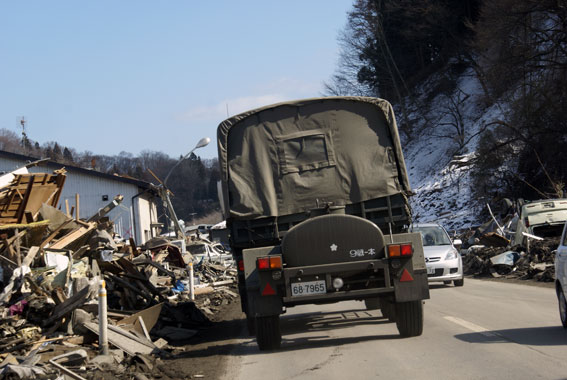 |
We then went to one of the refuge centres for central Kamaishi to find Yukako Sawadas mother, sister-in-law and the two of her four children, who were in Kamaishi during the quake. The other two are in Sendiai/Tokyo. Mrs Sawada was out with a tour group, visiting the dead bodies in the hope of seeing her husband again, one last time. However as yet his body has not been recovered to be identified. We gave all the items we had brought to either the sister in law – Kyoko Sawada – or the refuge centre itself. As it was about 15:00 and we could not talk with Mrs Sawada at that moment, we decided to continue on down the cost to see if we could find Kazue Sato in Ofunato. We were not sure if or where she could be but had a few hours of dailight left and still 3/4 of a tank oif fuel.We knew her addressand I have visited her in Ofunato before. We agreed to return and take the Sawada’s back with us( if Mrs Sawada would agree) to Towa cho on our return from Ofunato. |
By this point we are disorientated. South side of Kamaishi |
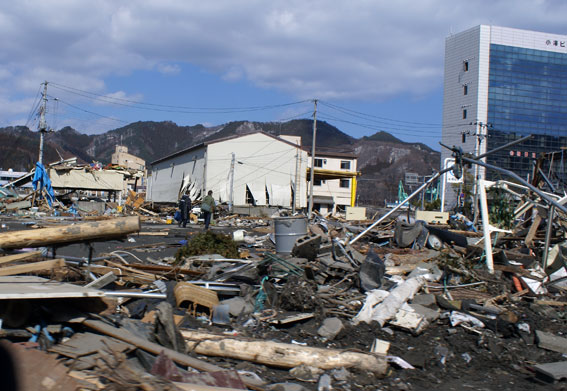 |
The road to Ofunato from Kamaishi runs along the coast, pocketed by small fishing, farming and industry communities. Each one had been (almost) completely wiped out. The road surface was buckled and torn from the quake, at intervals all along the 40 or so kms. Some workers could be seen still making temporary patches. The landscape here and for most of the Iwate cost line is mountainous. Think the west coast of Scotland blanketed in Cedar, Pine and oak forest. There are many long narrow bays almost like sea lochs. During the trip we stopped to pick up an old man – clearly not having washed for some days, hobbling, out of breath and in the pitch black, though one of the many tunnels. He told us he was on his way to Rikuzentakada. We were a little surprised as this wassouth of Ofunato and a good 40kms from where we picked him up. It was getting close to 17:00 |
South side of Kamaishi |
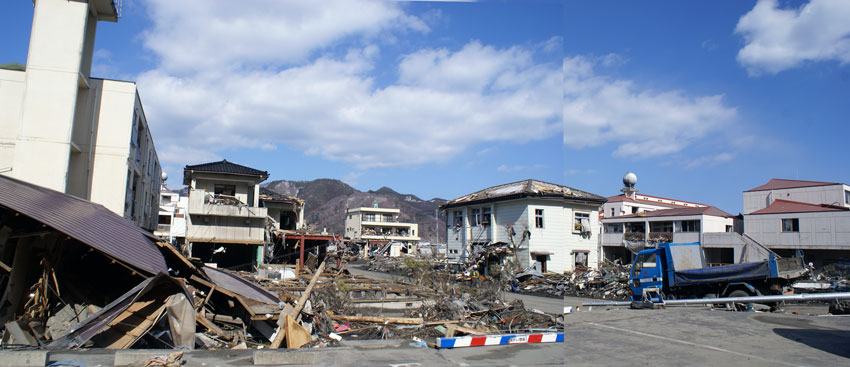 |
Coming into Ofunato again things looked almost normal until we got down closer to the low lying areas of the town. We decided to look for Kazue Satos family house, and so stopped at the Riaz Museum of Art to get Directions and some possible information. The museum is acting as the largest refuge centre for Ofunato. The staff there told us that possibly the Ofunato Dai district we were looking for had been destroyed. We posted a note on the notice board and continued on to the refuge centre nearest to the Ofunato Dai area. |
crossing over to the north side of Kamaishi |
 |
Again this next refuge centre was an elementary ot Junior high school. Very busy with people on every inch of floor space. We spoke to a man at the desk who helped give us information about the Dia area and located the address we were looking for in an address map book – familiar to all in Japan.naoko politely asked if he and his family were all OK. He told us that several members of his family were “ still underneath our house”as he put it. He was able to tell us also that the next door heighbour of Kazues’s was here in the centre. He took us to them, and we discovered that they were not Kazue’s next door neighbour, but her Uncle and Aunt. They were having their evening meal and were very happy to see us. They told us that Kazue was alive and well, staying in her parents house just down the road from the refuge centre. |
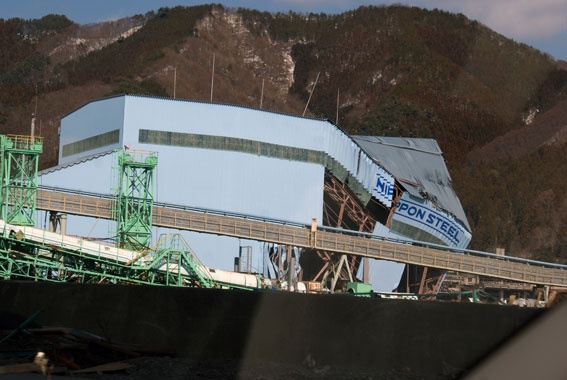 |
Unfortunately we had given everything to the refuge centre in Kamaishi.When we got to the house Kazue, her mother and father were indeed at home, with one candle lit for light, no running water or electricity. They all definitely needed a bath.They did have gas for cooking thought, so we gave them the eggs that no-ne seemed to need in Kamaishi. Kazue told us of her experience, having ushered her students to the second floor of the school,and at being glad that she did not choose to try and flee in her car. The roads in Rikuzentakada were jammed with cars trying to get out. Her car was everntually washed away along with all the others in the school car park. Spending the night with her students on the second floor of their high school in Rikuzentakada. There was a lot of devistation down there also. Although we wanted to offer, we could not take Kazue's family with us as we had promised to return to Kamaishi for the Sawadas
|
|
North side downtown of Kamaishi |
 |
It was dark and late so we headed back to Kamaishi. When we got there we finally met Mrs Sawada. She said that she would have gladly come with us, but wanted to stay until she could see/find her husbands body. She told us how her husband had left the Nozomi hospital where he was having his pacemaker checked. He had insisted that he pop back home to make sure his wife was OK. His daughter, Yukako had ordered him to stay in the hospital, as she was herself in that building, but he slipped out when no one was looking. The other Sawada’s would not leave Mrs Sawada in the shelter. There are applications forms to fill and have processed for all sorts of things, not least of which is a formal request for housing. I supose if you are not there the house goes to the next in line. |
North side downtown of Kamaishi |
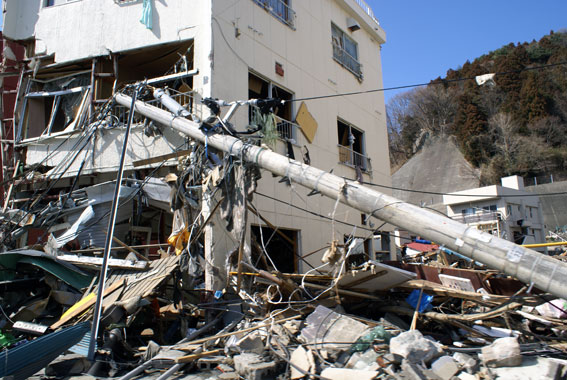 |
We then decided to go back to Ofunato to ask if Kazue and her parents want to spend one or two days with us, have a bath and such. On the journey back to Ofunato, we picked up a man – jogging along the road in the darkness. WE were about 14kms outside of Ofunato. He said he worked for a funeral parlour and had been driving around all week picking up bodies but tonight he wanted to get back to Ofunato and see if his home was still OK. He did not want to use up the companies fuel and so was walking/running the 20km distance! Back at Kazue’s parents house we were told, kindly, that there are too many things to be done. The uncles house is buried in mud and has to be cleaned out. 100 other things need to be done.No one really wants to be seen to take an offer of comfort/ support or help before anyone else. We were disappointed but understand. This is also Japan.
|
Parked the car here, close to our friends street |
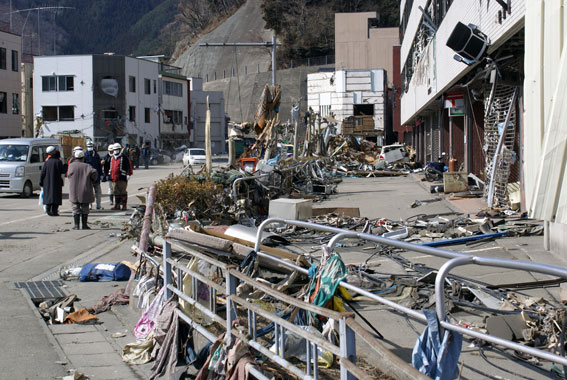 |
We headed home. About 5kms outside of Ofunato on the Route 107 road to Kitakami we passed dozens of parked cars with their hazard lights flashing. They were all stopping here as this was the closest spot to Ofunato where a mobile phone signal can be received. |
 |
||
Hamacho 1 area, Kamaishi |
 |
|
Intially we thought this was Hamacho 1, where the sawada's lived. This is Hmacho 2 area |
 |
|
The Sawada's front house is on on the right hand side, about where the white car sits. |
 |
|
Man standing in an upstairs window, clearing out salvagable items |
 |
|
between Hamacho1 and Hamacho 2 areas |
 |
|
High water mark between Hamacho1 and Hamacho 2 areas |
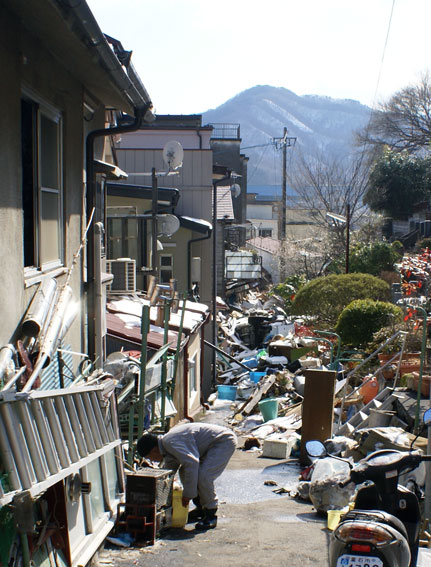 |
|
Front entrance to Kamaishi Shoukin Centre and Nozomi Hospital |
 |
|
Close by to hospital, high water mark, at the bottom of the steps leading up to a shrine complex. |
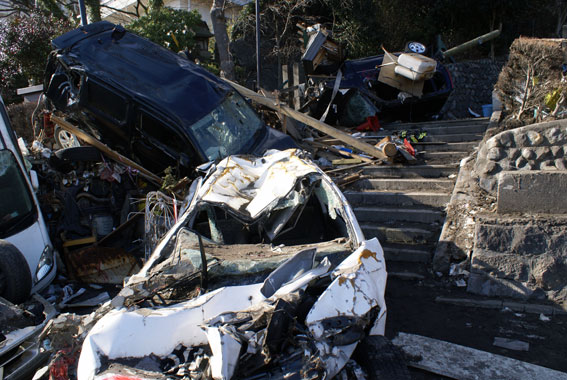 |
|
High water mark, at the top of the steps seen in image above |
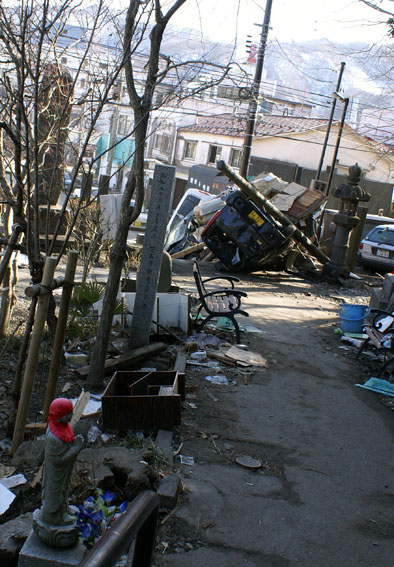 |
|
Looking west towards Hamacho 1 area |
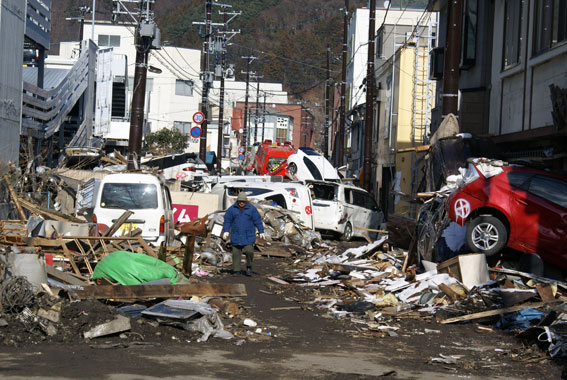 |
|
High water mark, just south of the brindge over the river and close by to the train station |
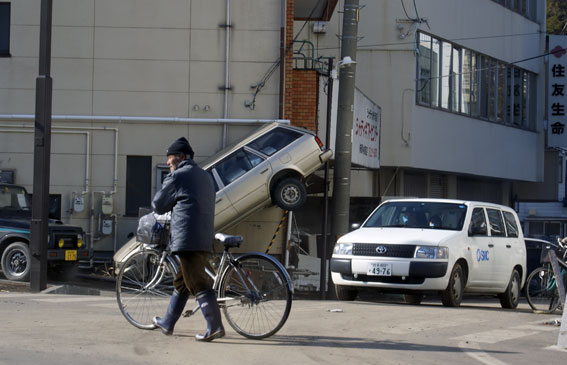 |
|
view across the river to the back of Kamaishi train station |
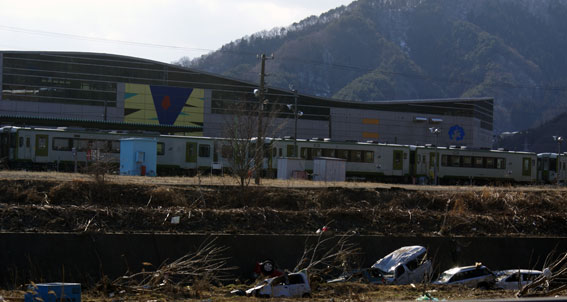 |
|
Green shows where we parked. Red locates the Sawada house in Hamacho 1 Hamacho 2 is to the left of this Blue locates the Nozomi hospital |
 |
|
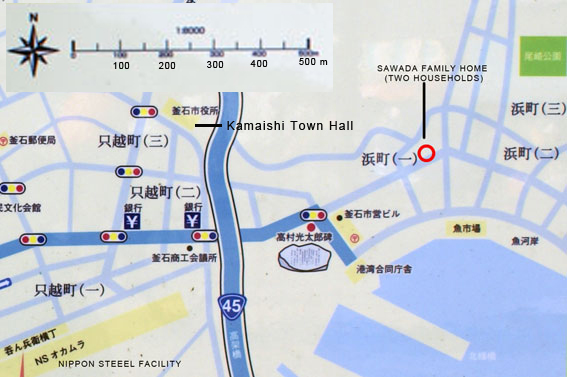 |
||
High water mark shown on the side of the building as we leave kamaishi for Ofunato. |
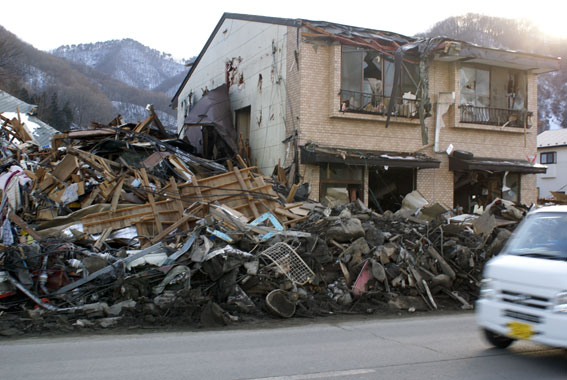 |
|
View across harbour area towards Nippon Steel. The low forground building is 5m high |
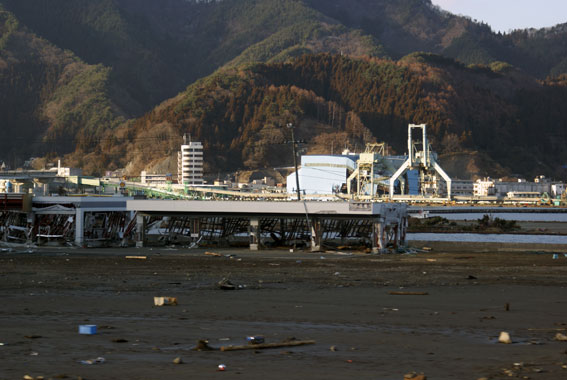 |
|
the first indusrtual bay to the south of Kamaishi city. also heavily damaged |
 |
|
Debris on the breached side of Route 45, next bay down from Kamaishi |
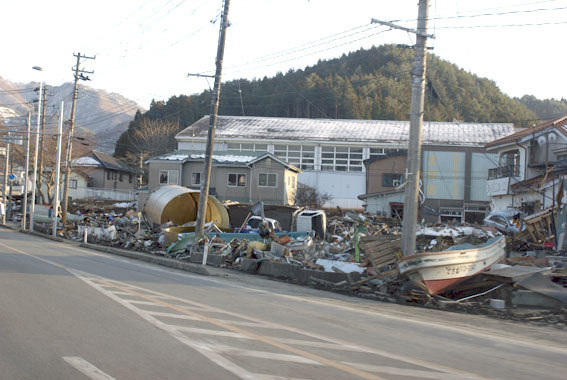 |
|
the next town down the coast. The subsequent four photos show some details of this overall image. The area has yet to be touched by mechanical diggers/ bulldozers |
 |
|
breached 10m high defensive sea wall |
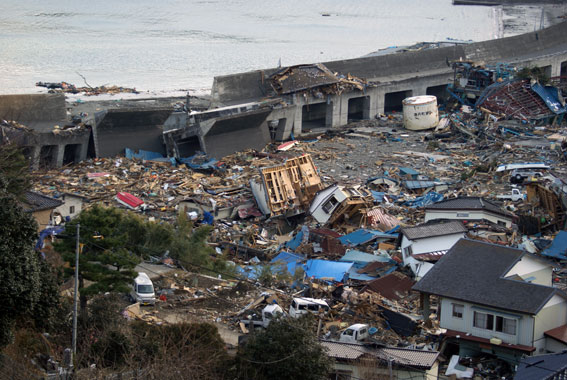 |
|
the second floor (probably bedrooms) of two houses |
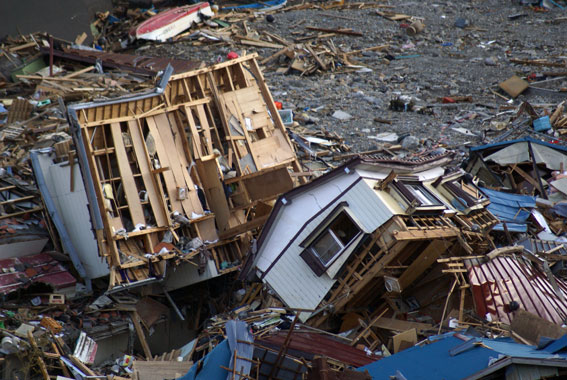 |
|
above 20 metres the houses were unscathed |
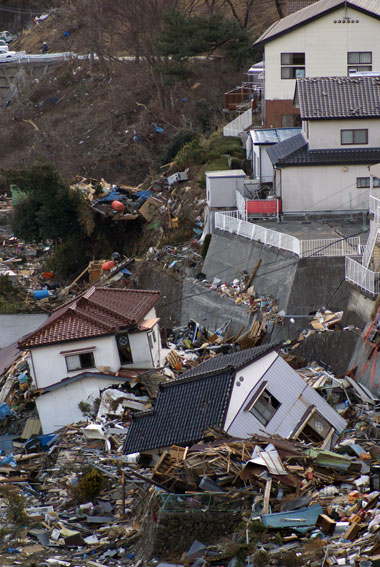 |
|
Second floor of a house pushed up within the 20 high level |
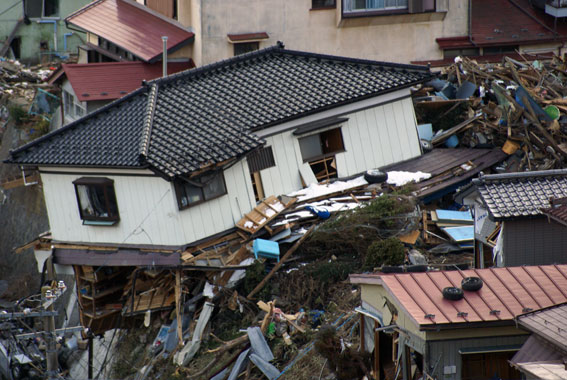 |
|
Sea wall defences(again 10m high) of the next town down the coast |
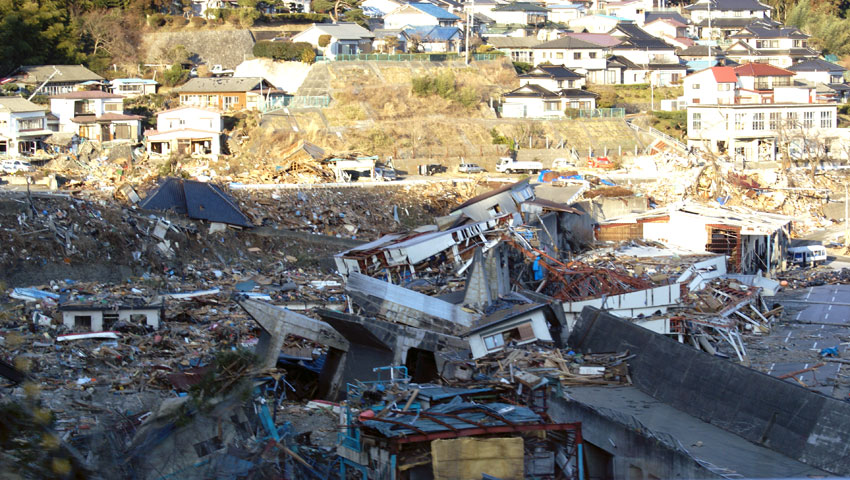 |
|
The next bay , where the main costal road, Route 45, had been breached (and now cleared) by debris |
 |
|
As we travelled south, this is the next Industrial and residential area down the coast. |
 |
|
The same Industrial and residential area looking back as we drive south. |
 |
|
The next bay was a farming and residential bay with sea wall defences |
 |
|
Detailed view of the same farming and residential area. |
 |
|
Detailed view of same farmingl and residential area. The road sign pole has spun 180 degrees on its axis but remains absolutely vertical. The sign shows Ofunato pointing to the north. Ofunato is south of here. The road it signed was unidentifiable. |
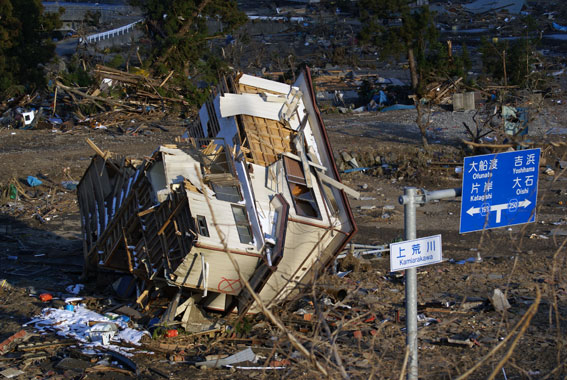 |
|
About half way through a 2km long blacked out tunnelWe picked up this old man, on his way to Rikuzentakada |
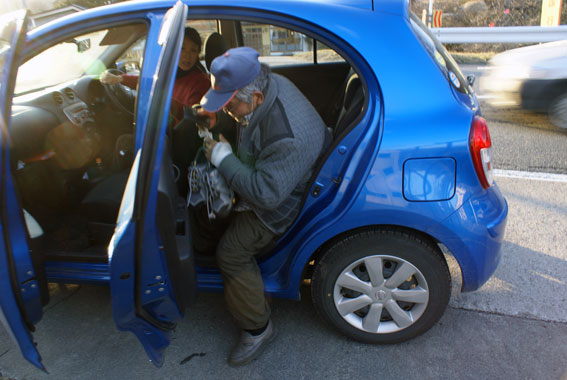 |
|
During the trip he repeatedly tried to get us to accept 1000 yen as payment for picking him up. |
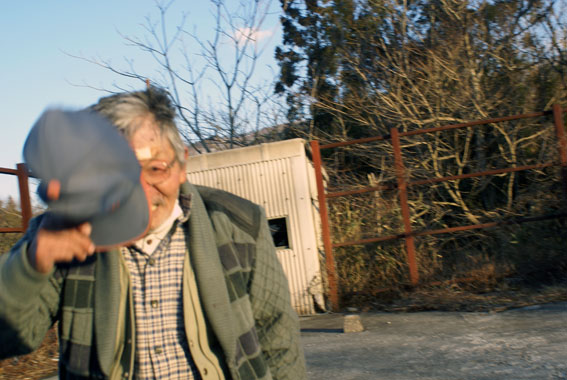 |
|
Tunnel view without electricity |
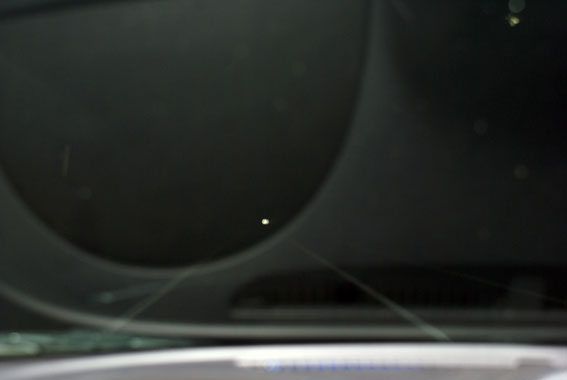 |
|
Temporary repair to Route 45 |
 |
|
A glimpse of Ofunato bay as the sun sets |
 |
|
moonlit photo (15 second exposure) of Ofunato taken standing at the end of Kazue Sato's street.
Her harbourside studio was located about 200m down below to the right |
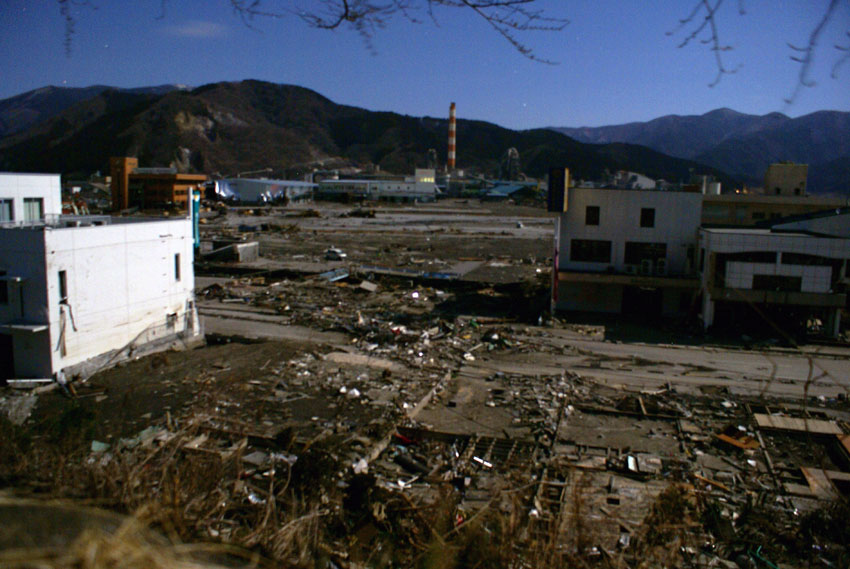 |
Thursday 17th March 2011
06:40 queuing for petrol to be given out at 10:00

It is now the morning of the 17th and I am a bit frustrated about the lack of information. However I try and give an accurate picture of our situation. We are by no means in a disaster situation, like you will have seen on T.V. However, we are all being affected. We had no electricity for at least 48 hours after the quake struck, so no television, only a transistor radio for info. We had no telephone; land or mobile, until Monday and we still have no Internet feed to the house. Currently piggybacking using Naoko’s JICA company computer and airport /mobile card.
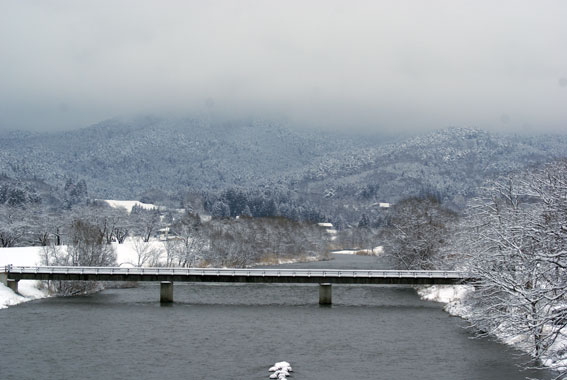
Tokyo/Osaka this is not.
We live in a community of approximately 10,000 people, mostly farmers, scattered over a wide area. We are under the jurisdiction of Hanamaki city, a town of about 80,000 people, which is located approximately 10kms away. Hanamaki is about 300kms north of the Fukushima nuclear facility that is in trouble. We (Naoko, Moira, Naoko’s Mother and I) are currently housing Naoko’s sister’s family (Keiko & Ko-chan Ito, and there two children), who have come to stay with us for the time being. Their house, located in our main town of tsuchizawa/Towa-cho, has suffered foundation damage in the initial quake. The house may not be about to fall down, but the quakes and tremours are still occurring – another big one last night around 23:00. Another one just now as I type. At the moment we are eight in the house.
Supermarket Shopping on the morning of the 16th
I went into Hanamaki with my brother-in-law (Ko-chan) to do some shopping, as we needed the basics. Until then I had not ventured beyond the downtown Tsuchizawa area of Towa-cho since Friday. On the outskirts of Hanamaki we had to queue for about half an hour to get into Big House (a kind of discount supermarket) and were allowed only 2 litres of milk and two packets of Tofu per shopping group! We split up, and so, got 4 of each item we were allowed. There was some fish (frozen Salmon from Chile) and vegetables (carrots potatoes, various mushrooms, cabbage, pumpkins etc), although the tomatoes were definitely on the turn. We went to a further two supermarkets to get some more milk and tofu, but everything was sold out. Dried foods, canned foods and all those lovely chocolate biscuits are still in abundance, as is cheese, always rubbery and outrageously overpriced at the best of times.There were long queues for petrol in Hanamaki, all along Route 4.


Putting fuel in the car on the 17th May
This morning at 06:00 there was an announcement on community radio saying that petrol would be delivered to the local petrol station at 10:00. Ko-chan and I rushed out of the house immediately and managed to get into line in our cars within 5 minutes. There was already a queue of over 100 cars by this time. Most of who had been sitting there over night. The composite photo here was taken at 06:30. By 07:30 the queue was about 7kms long. By 08:00 a petrol pump attendant was sent to tell everyone beyond a certain point that no fuel would be available this far back - approximately 800 vehicles. I would estimate about the same number again, at least, would have turned back home. All vehicles were rationed with 2000 yen worth of fuel (about 15 GBP), which equates to 13.7 litres per vehicle. I was able to get fuel by 10:30. Ko-chan said that there would be no second delivery of fuel for at least 3 days. After that we still do not know. The cost has jumped by 10%
|
Images of Sun Life supermarket. 17th March 09:00
Notice on the door of the Agricultural Co-op supermarket
Between 06:30 and 10:00, I walked into town and back again, asking a few questions here and there. Our local Agricultural Co-op supermarket (about the size of Scotmid half way down Leith walk if that means anything to you) has a sign announcing it has closed from the 16th until further notice. It does have the dried/tinned foods as I saw through the window, but no fresh produce is available. I then walked to the other supermarket – Sun Life – and about the same size. The photos I took show the interior and the exterior. The fruit/veg photo shows all fruit/veg for sale at 09:00( mostly you can see oranges, grapefruit, avocado and Kiwi fruit). The tills are all closed and an impromptu stall has been set up outside where produce is on display – This is the only shop currently selling food within our entire 10,000-population community. Our one convenience store is closed.
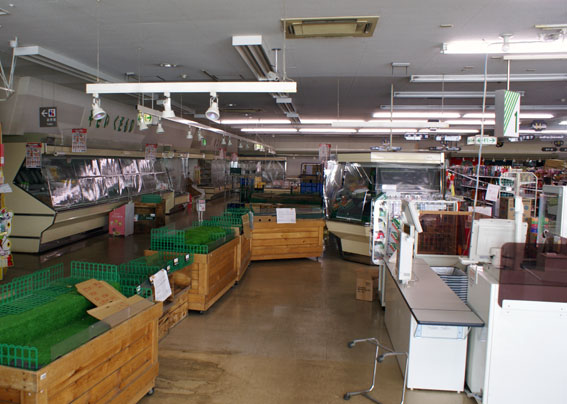 |
 |
 |
 |
12:30:A friend of Naoko’s has just phoned asking if I know if the shops are open and selling food in Hanamaki today? Anyone here in Towa now needing food essentials will have to drive 20kms round trip.
13:00:Ko-chan has said that there will be a delivery of basic produce at Sun Life today from 14:00. All fresh produce will have gone by this evening, I expect – except those avocados.
18:00: As I passed this evening, Sun life is closed for business.
As you can see its not as bad as it might sound, also most people will have stocked up. However, there is little fuel in everyone’s cars, and in a rural community almost everyone drives to work. The Kamaishi-Hanamaki train line has been out since Friday and will not be resuming any time soon. I guess everyone within Hanamaki is walking to work. Naoko’s mother was told that the main petroleum supplier for the whole of Tohoku, north of Sendai, was damaged in some way and so they are not able to deliver petrol to this whole region. Iwate, Aomori and Akita are the three most northern prefectures, all predominantly rural. The combined population total is around 15 million people. I guess we are all being rationed petrol and fresh produce at the moment, although I can only verify what we are experiencing here in Towa Cho.
Towa Cho is on the main road to Kamaishi and there are Japan defence force trucks and Red Cross trucks to be seen heading to Kamaishi. Here is a link to our colleagues who visited Kamaishi yesterday. It is all in Japanese but has some photos taken in the last few days.The road is therefore now open again. The helicopters are still to be heard and seen all day. However, most people have little or no fuel in their vehicles and so cannot travel any great distance – not the 200 + kms round trip to Kamaishi unless they want to use up their ration of petrol. However, Naoko and I hope to go tomorrow or the day after, with a small group of people utilising vegetable oil and diesel vehicles. We will know more about this tonight and hope to bring essential supplies. I want to go with our car – and have been wanting to since Sunday – but we are not absolutely sure where our friends are located in Kamaishi. Their house was definitely ruined. They lived about 100m from the harbour front but the family are all definitely alive. We have heard nothing yet about Kazue Sato and her (elderly) parents.
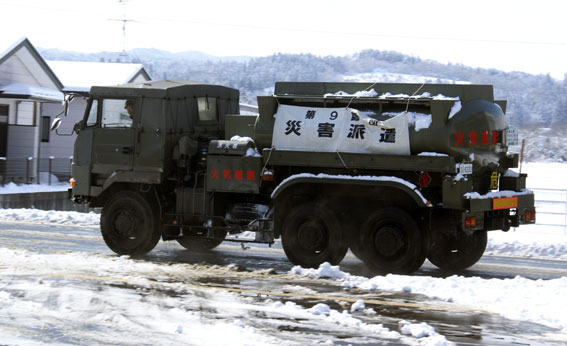
Fukushima Dai-Ichi power reactors.
Basically, all I know is what I see on NHK News, read on Kyodo news, BBC and The Guardian. In reality there is little we can do – except carry on or flee the country.We are keeping Moira and the Ito children indoors since Monday. It has been snowing each night for the past three nights and I can only assume that there is (low level?) radiation around and about. I would prefer to stay a bit longer to help people in Kamaishi if possible. We have a big enough house with all facilities working as normal – Internet aside. In Kamaishi they have the clothes they fled in and what the self-defence force brings in. There is a basic lack of everything there down to a change of underwear.

